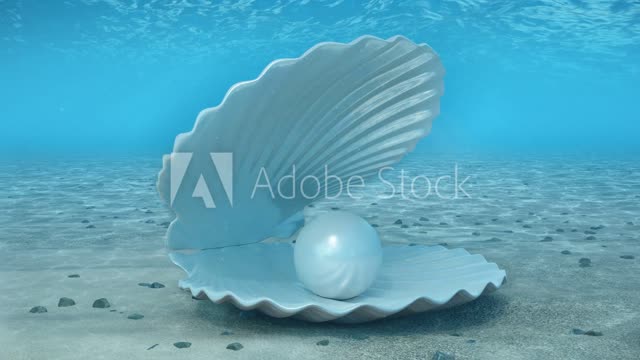Premium Only Content

How India is building a pearl farming industry
http://destyy.com/edHbkM
By Priti Gupta Mumbai
Mr Garwa expects to produce 3,000 pearls this year
In 2016 Narendra Garwa was facing a desperate financial situation. His small book store in the village of Renewal, Rajasthan, was running at a loss.
With a family to support and little education, he searched the internet for other money-making ideas. He had some success growing vegetables in plastic bottles, but then came across a potentially more profitable crop - pearls.
"Rajasthan is a dry area with water issues. It was a challenge to think of growing pearls with limited water but I decided to try," he says.
Pearls are formed when a mollusc reacts to an irritant in its protective membrane. The mollusc deposits layers of aragonite and conchiolin, which together form nacre, also known as mother-of-pearl.
In the wild, pearl formation is rare so most pearls sold these days are from farmed molluscs, usually oysters or freshwater mussels.
Pearls are still gathered by divers from wild oysters and mussels
To spur the mollusc to form a pearl, an irritant is artificially introduced into the creature. However, it is a delicate process and the mussels or oysters must be carefully handled, as Mr Garwa found.
"My first attempt was a disaster," he admits. Of the 500 mussels he purchased, only 35 survived.
Mr Garwa had travelled to Kerala to buy the mussels - a journey of 1,700 miles involving a 36-hour train journey. He also used his savings and borrowed money to come up with the 16,000 rupees (£170; $200) needed to buy the molluscs.
In addition, Mr Garwa had dug a 10ft by 10ft pound in his back garden to keep the creatures in.
Despite the setback, he did not give up. Instead, he took a five-day course in pearl farming.
"Growing an oyster is like bringing up a baby," he says.
"Monitoring the water throughout the growth period is crucial to achieving high quality and volume of production."
Now he has a 40ft by 50ft pond, which he treats with multivitamins and alum which maintains the correct pH level required for growth.
Pearls are formed by oysters or mussels reacting to irritants
The survival rate of his mussels has risen from 30% to more than 70% since becoming more familiar with the process. Mr Garwa expects to produce around 3,000 pearls this year, which he can sell for between 400 and 900 rupees (£4-£10; $5-$11).
The Indian government has been encouraging pearl fishing as part of its Blue Revolution, a plan to modernise the nation's fishing industry.
Under the scheme, the government pays for half the cost of setting up a pond for pearl fishing, and so far the Department for Fisheries has given financial support to 232 pearl farming ponds.
"Pearl farming is one of the most lucrative aquaculture businesses and the government is encouraging farmers to take up this farming," says Jujjavarapu Balaji, Joint Secretary of Marine Fisheries.
China's high-quality pearls dominate the international markets
Not everyone is impressed with this wave of pearl farming activity. Critics include Gunjan Shah, who is the fifth generation of his family to be in the pearl trading business.
About us https://bit.ly/3GUPFOa
Contact us +919942258153 kvk.subadhra@gmail.com
Thank You Very Much for Sharing YourValuable Thoughts
https://aeb8c6tf-106m0d81bnes6-z75.hop.clickbank.net
-
 LIVE
LIVE
Steven Crowder
2 hours ago🔴 Donald Unleashed: How Trump is Putting the Fear of God into Illegals and LGBT Radicals
37,801 watching -
 LIVE
LIVE
The Rubin Report
1 hour agoCongress Sits in Stunned Silence After RFK Jr.’s Brutal Fact-Based Wake-Up Call
3,321 watching -
 LIVE
LIVE
LFA TV
15 hours agoNOMINEES ASSEMBLE! | LIVE FROM AMERICA 1.30.25 11AM
3,971 watching -
 LIVE
LIVE
Bannons War Room
9 hours agoFBI Director Nominee Kash Patel Testifies at Confirmation Hearing
14,834 watching -
 LIVE
LIVE
Benny Johnson
3 hours ago🚨PANIC: Kash Patel FBI Director Confirmation Hearing LIVE Right NOW | Deep State on Life Support
29,310 watching -
 DVR
DVR
Rethinking the Dollar
1 hour agoThursday Morning Check-In: Trump Plays Blame Game, Fed Pauses and Metals Respond
5.74K -
 LIVE
LIVE
Matt Kohrs
11 hours agoMarket Open: New Highs Incoming! (META, NVDA & TSLA) || The MK Show
744 watching -
 DVR
DVR
Man in America
2 hours ago🚨 RED ALERT: Did Trump Just BREAK the Bank of England? This Could be HUGE!
1.42K2 -
 43:25
43:25
BonginoReport
5 hours agoRFK Jr. Goes To War With Big Pharma (Ep.129) - 01/30/2025
81.5K60 -
 1:25:26
1:25:26
Graham Allen
3 hours agoHelicopter CRASHES into plane over DC! + RFK Hearing Gets INTENSE And META To Pay Trump $25M!
64.1K28